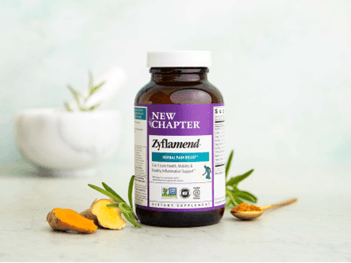Written By New Chapter Canada
We’ve all heard the remarkable upsides of physical activity. Regular exercise is linked to so many benefits, including more restful sleep and better energy, stronger bones and healthy weight, and even increased lifespan. Exercise is so important that the Centers for Disease Control & Prevention make it a cornerstone for healthy living, recommending adults get at least 2 hours and 30 minutes of moderate-intensity activity each week and do muscle-strengthening activities on 2 or more days.
Fitness Includes Proper Recovery
What government guidelines aren’t mentioning is that you also need time for the body to recover after exercise. Your body does a lot of behind-the-scenes work to maintain or build fitness. Exercise and training essentially put your body through systematic physical stress. Whether it’s yoga flows, weight training, running, cycling, swimming, team sports, or another favorite way to get moving, a good workout causes microscopic damage at a cellular level. Don’t worry though! This is part of fitness and getting stronger. This physical stress leads the body to repair and strengthen, and ultimately builds fitness. Rest and recovery allow you to get the maximum benefit from workouts.
A Look Inside the Effects of Exercise
When you work out, you’re fatiguing various muscles and causing mild damage to muscle cells. Hormone and enzyme levels fluctuate, and inflammation temporarily increases. But these changes you’re causing will resolve to do your body good. They lead to muscle growth, improved cardiovascular health, and an overall healthier body. The repaired tissues—from your muscles and bones to heart and lungs—become slightly fitter than they were before. Repeated again and again, this process of stress and sports recovery is what results in improved health and fitness. So, here’s an important DO: give your body time for those good changes to happen before you start stressing it out again! For example, plan both workout days and rest days in your week. This is particularly important if you’re training for something specific like a race or sports event.
How long does muscle recovery take?
The time it takes for muscle recovery after exercise or sports varies depending on the intensity of the exercise and your own levels of physical fitness. In most cases, muscles should be recovered within 24 to 48 hours. However, if you’ve really pushed yourself hard, your muscles may need more time. Depending on your training and the measures you take after it, the recovery of your muscle fibers may take between 42 and 72 hours.
Types of recovery
Impact from exercise triggers your body’s immune system to help with recovery. General phases of healing after physical activity and sports workouts are inflammation, proliferation, and regeneration.
Phase 1: Inflammation
During the inflammation phase, the body sends specialized cells and molecules to the affected area, including nutrients, immune cells, and oxygen.
Phase 2: Proliferation
Proliferation is the phase where new tissue is formed.
Phase 3: Regeneration
Regeneration is the phase where the new tissue is remodeled to match the surrounding tissue.
Supplements and Herbs to Help with Post-Workout Recovery
There are several supplements and herbs that can help with post-workout recovery and sports nutrition.
Vitamins and minerals can help support effective workouts. Nutrients including Vitamin C, Vitamin E, Zinc, Selenium, and Magnesium are necessary for tissue repair, creating new tissue cells, and fighting inflammation with antioxidant action. Our whole family of New Chapter vitamins and minerals are expertly formulated by scientists for your body to absorb and feel the difference. Or try Magnesium + Selenium & Zinc for a 3-in-1 blend of key minerals to replenish and recharge after exercise.
Water + electrolytes are important, too. They rehydrate and restore depleted muscles so you’re ready for your next workout. Together, water and electrolytes (which can include sodium and potassium) help replace compounds you lose through sweat.
Herbs can support healthy inflammation response and effective post-workout recovery, such as the 10 herbs in Zyflamend from New Chapter. *† Keep reading for details!
Ginger for Pain Relief After Exercise
As the body responds to the effects of exercise and workouts, it’s common to experience pain or soreness in the muscles or joints. For example, delayed onset muscle soreness (DOMS) can be felt occasionally on post-workout days. You may also feel achy after any activity, including physical therapy, climbing stairs, walking, dancing, chasing kids, and so forth. Zyflamend can help! This clinically studied 10-herb blend from New Chapter features Ginger for herbal pain relief. *† Ginger lets you take a powerful herbal approach to healthy inflammation response, helping your body to respond to inflammation at the source and therefore reduce pain. *† Zyflamend is formulated with potent Ginger to help to soothe soreness related to exercise and support your body’s healthy inflammation response. *†
Recovery Support from Turmeric, Green Tea & More
Zyflamend is a favorite for any active lifestyle because it helps support healthy joint function, mobility, and flexibility. * In fact, Zyflamend has been clinically studied in healthy populations for improving mobility, measured in distance walked. The group taking Zyflamend for 12 weeks walked significantly farther than the placebo group. Another cool fact about Zyflamend? The ten herbs in Zyflamend have been shown to have unique herbal synergy. That means they work better together as a blend than if you took each herb separately (as shown in preclinical lab testing). A significant multiplying effect was observed in Zyflamend’s particular combo of Ginger, Turmeric, Green Tea, Rosemary, Holy Basil, and 5 other traditional herbs. It’s a perfect case of the whole being greater than the sum of its parts—or as we say at New Chapter, one plus one is greater than two!
5 Quick Tips for Workout Recovery
Here’s a recovery cheat sheet for you. We’ve gathered five ways you can help your body do its job to reset, rebalance, and get ready for whatever’s next.
- Foam roll—Take time after workouts to massage muscle groups with a stiff foam roller or other roller device. This type of self-massage can work certain spots deeply, relieving tension, pain, and tightness to help with overall recovery and flexibility.
- Hydrate—It’s common knowledge that bears repeating: If you feel thirsty, you’re already slightly dehydrated. Drink water or other fluids during exercise if you can, and aggressively re-hydrate after workouts. Water helps muscle tissue, cushions joints, and also flushes toxins as your muscles recover from exercise.
- Fuel—Getting protein soon after workouts gives your body tools to rebuild. Replenishing carbohydrates is also essential nutrition, since they get stored as glycogen—your body’s workout fuel. So, your post-workout protein-carb combo could be something like yogurt and berries, a shake with protein powder, or tuna on whole-grain bread. Make it easy and delicious!
- Supplement—Does your body have everything it needs for optimal recovery? Supplement nutrition you get from food with whole-food fermented multivitamins that are formulated for absorption. Then add Zyflamend, New Chapter’s targeted 10-herb blend that supports joint function and mobility, and features Ginger for pain relief after exercise. *†
- Sleep—Adequate sleep is a crucial part of reaping the benefits of being active. Sleep lets your body focus on repair, hormone release, and is even linked to better decision-making skills. Adults should generally get 7+ hours of sleep a night. Check out our sleep hygiene blog for more great sleep tips!
Science on how to speed exercise recovery
There are several kinds of sports recovery interventions that have been proposed to improve recovery after physical exercise. A meta-analysis evaluating the impact of recovery techniques on delayed onset muscle soreness (DOMS), perceived fatigue, muscle damage, and inflammatory markers after physical exercise found that active recovery, massage, compression garments, immersion, contrast water therapy, and cryotherapy (cold therapy) induced a small to large decrease in the magnitude of DOMS. Massage was found to be the most powerful technique for recovering from DOMS and fatigue.
Experts sometimes talk about two types of recovery: active recovery and passive recovery. Active recovery may be a short period of low-intensity exercise that a person does after higher intensity exercise to improve their recovery and performance, such as walking or swimming. Passive recovery refers to resting after an activity. People may use one or the other method at different points to suit their training needs.
Here’s to recovering well!
Take great care of your recovering body between workouts to build fitness and help you feel and perform your best! When you plan your weekly workout or training time, you can also build in disciplined sports recovery between workouts to optimize the benefits. Give your body the right ingredients to support comfort and healthy inflammation response, like #1-selling Zyflamend for whole-body wellness.



 Monthly Specials
Monthly Specials








